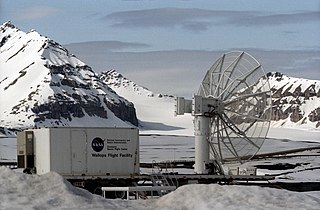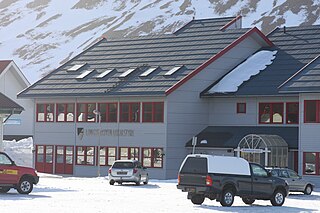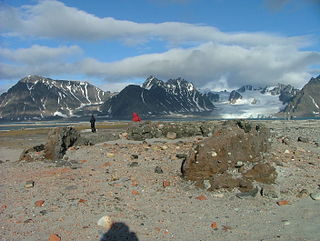
Svalbard, previously known as Spitsbergen or Spitzbergen, is a Norwegian archipelago in the Arctic Ocean. North of mainland Europe, it lies about midway between the northern coast of Norway and the North Pole. The islands of the group range from 74° to 81° north latitude, and from 10° to 35° east longitude. The largest island is Spitsbergen, followed in size by Nordaustlandet and Edgeøya. The largest settlement is Longyearbyen on the west coast of Spitsbergen.

Spitsbergen is the largest and the only permanently populated island of the Svalbard archipelago in northern Norway.

Svalbard and Jan Mayen is a statistical designation defined by ISO 3166-1 for a collective grouping of two remote jurisdictions of Norway: Svalbard and Jan Mayen. While the two are combined for the purposes of the International Organization for Standardization (ISO) category, they are not administratively related. This has further resulted in the country code top-level domain .sj being issued for Svalbard and Jan Mayen, and ISO 3166-2:SJ. The United Nations Statistics Division also uses this code, but has named it the Svalbard and Jan Mayen Islands.

Longyearbyen is the world's northernmost settlement with a population greater than 1,000, and the largest inhabited area of Svalbard, Norway. It stretches along the foot of the left bank of the Longyear Valley and on the shore of Adventfjorden, the short estuary leading into Isfjorden on the west coast of Spitsbergen, the island's broadest inlet. As of 2002 Longyearbyen Community Council became an official Norwegian municipality. It is the seat of the Governor of Svalbard. The town's mayor is Arild Olsen.

Bonnyville is a town situated in East Northern Alberta, Canada between Cold Lake and St. Paul. The Municipal District (MD) of Bonnyville No. 87 surrounds the community.

The Svalbard Rocket Range or SvalRak as it is named, is a launch site for sounding rockets at Ny-Ålesund in Svalbard, Norway. The site has been in use since 1997 and is owned by Andøya Space Center, which is owned by the Norwegian Ministry of Trade, Industry and Fisheries and the Kongsberg Group. SvalRak's location at the 79th parallel north makes it well-suited for launching rockets to investigate Earth's magnetic field. It is used mostly by American, Japanese and Norwegian researchers. It is the world's northernmost launch site.
Arctic Mars Analog Svalbard Expedition (AMASE) uses Mars analog sites on Svalbard for testing of science questions and payload instruments onboard Mars missions. AMASE has arranged annual expeditions on Svalbard since 2003 and is run by Vestfonna Geophysical AS and funded by the Norwegian Space Centre, ESA and NASA.

The University Centre in Svalbard is a Norwegian state-owned limited company that is involved in research and provides some higher education in Arctic studies. The company is wholly owned by the Ministry of Education and Research, and the universities of Oslo, Bergen, Tromsø, NTNU and NMBU appoint the board of directors. It is led by a director appointed by the board for a four-year term. The centre is the world’s northernmost research and higher education institution, in Longyearbyen at 78° N latitude. The courses offered fall into five main science disciplines: Arctic biology, Arctic geology, Arctic geophysics, Arctic technology and Arctic safety.
The Meadows is a residential district in the city of Edmonton, Alberta, Canada. Located in southeast Edmonton, the Meadows is bounded by Whitemud Drive to the north, 34 Street to the west, and Anthony Henday Drive to the east and south. The residential district of Mill Woods is immediately west of the Meadows across 34 Street, while Strathcona County is located to the east across Anthony Henday Drive.

The economy of Svalbard is dominated by coal mining, tourism and research. In 2007, there were 484 people working in the mining sector, 211 people working in the tourism sector and 111 people working in the education sector. The same year, mining gave a revenue of 2.008 billion kr, tourism NOK 317 million and research 142 million. In 2006, the average income for economically active people was NOK 494,700, or 23% higher than on the mainland. Almost all housing is owned by the various employers and institutions and rented to their employees; there are only a few privately owned houses, most of which are recreational cabins. Because of this, it is nearly impossible to live on Svalbard without working for an established institution. The Spitsbergen Treaty and Svalbard Act established Svalbard as an economic free zone and demilitarized zone in 1925.

Nybyen is a small settlement located on the southern outskirts of Longyearbyen, on the island of Spitsbergen, in the Svalbard archipelago of Norway. The name is Norwegian and translates as The New Town.

The 2011 Svalbard polar bear attack was an attack by a presumed starving polar bear on a group of university students and their guides. The bear killed one person, injured four others, and was then shot.

Longyearbyen Community Council is the local government for Longyearbyen in Svalbard, Norway. It has many of the same responsibilities of a municipality. It is organized with a 15-member council which since 2011 has been led by Mayor Christin Kristoffersen of the Labour Party. The council's main responsibilities are infrastructure and utilities, including power, land-use and community planning, education from kindergarten to upper secondary level and child welfare. It operates three kindergartens in addition to the 13-grade Longyearbyen School.

The archaeology of Svalbard is the study of human activity in the northerly Arctic Ocean archipelago's past. The geography, environment and climate of Svalbard have resulted in exceptional preservation conditions. Archaeological fieldwork on Svalbard is both expensive and physically exhausting, but new technology and infrastructure has allowed easier access. This easier access has also resulted in more damage caused by tourists.

Cannabis in Svalbard is illegal. Practically functioning as ungoverned terra nullius prior to the Svalbard Treaty of 1920, the Arctic Ocean archipelago dominated by glaciers and barren rock, is part of Norway, and hence Norwegian law applies. Under it, there is a sliding scale approach to cannabis legislation. Possession for personal use, defined as up to 15 grams, is punished with a fine of between roughly 1,500 and 15,000 Norwegian kroner. Possession of amounts larger than that is punished by jail, ranging from 6 months all the way up to 21 years. These laws are enforced by the Norwegian Police Service, the small Svalbard district of which is run by the Governor of Svalbard.
Uniquely, the Norwegian archipelago of Svalbard, located in the High Arctic, is an entirely visa-free zone. However, travelers who have a visa requirement to enter mainland Norway/the Schengen area must have a Schengen visa if they travel via mainland Norway/the Schengen area. This must be a double-entry visa so they can return to mainland Norway/the Schengen area.

Siti Aisyah Binti Haji Alias is a Malaysian marine polar researcher and lecturer. As of August 2016, she is Associate Professor and Director of the National Antarctic Research Centre (NARC) in the Malaysian Antarctic Research Programme (MARP), at the University of Malaya. Her work focuses on the physiology of marine and polar microbes and fungi.
S. Suresh Babu is an Indian atmospheric scientist and the head of the Aerosols, Trace gases and Radiative Forcing (ATRF) branch at the Space Physics Laboratory of Vikram Sarabhai Space Centre. Known for his studies on the Atmospheric aerosols, Babu is a recipient of the Young Scientist or Associate Award of all the three major Indian science academies namely, National Academy of Sciences, India, Indian Academy of Sciences and Indian National Science Academy. The Council of Scientific and Industrial Research, the apex agency of the Government of India for scientific research, awarded him the Shanti Swarup Bhatnagar Prize for Science and Technology, one of the highest Indian science awards, for his contributions to Earth, Atmosphere, Ocean and Planetary Sciences in 2017.
The COVID-19 pandemic in Svalbard is part of the worldwide pandemic of coronavirus disease 2019 caused by severe acute respiratory syndrome coronavirus 2. The virus was confirmed to have reached Svalbard on 6 October 2021.














